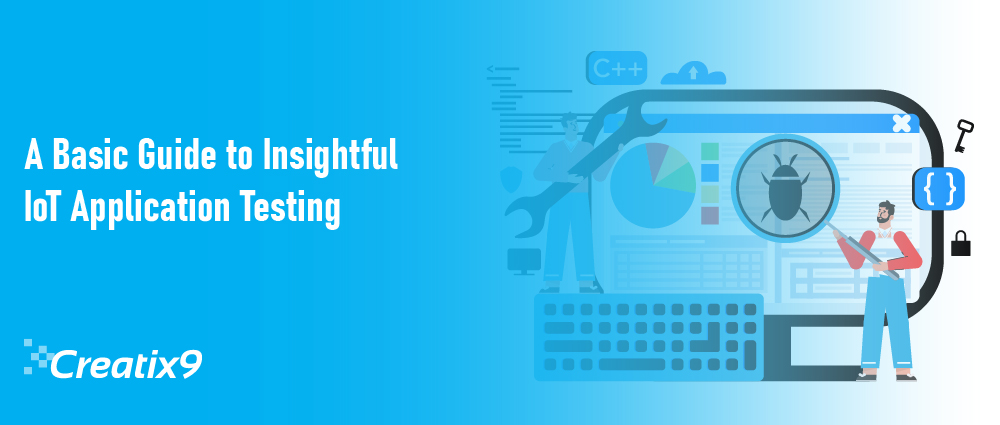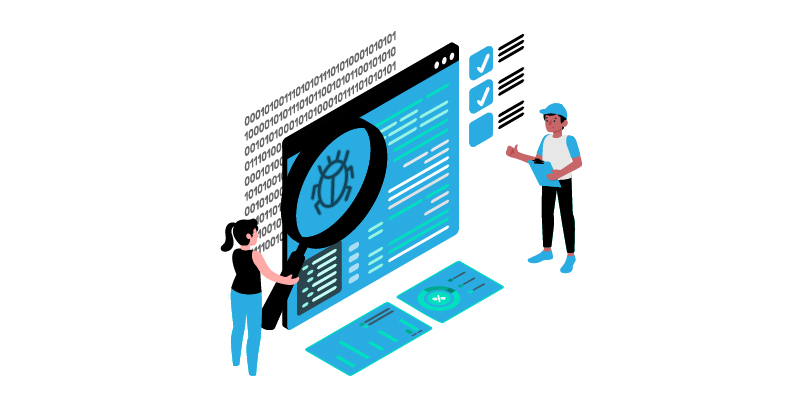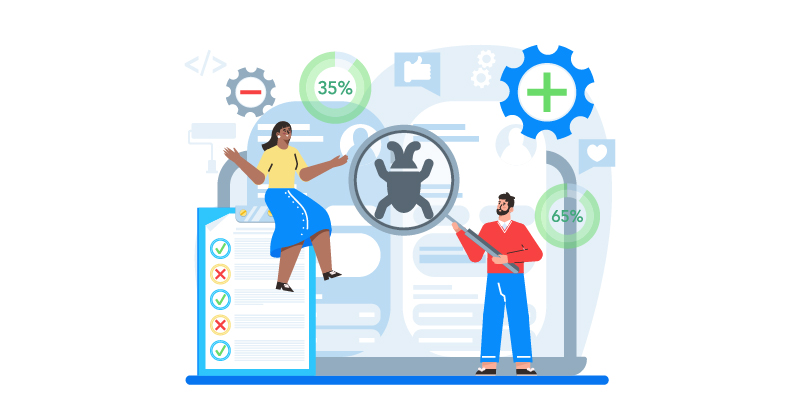
Creatix9 UK, with years of considerable expertise in providing IoT solutions. We have a thorough knowledge of the many features of IoT solutions. We provide premium, all-inclusive IoT application development and careful performance testing services from conception to implementation.
Our skilled IoT testing team comprises a test lead, a test automation lead, engineers for manual and automated testing, and a cybersecurity specialist. To meet their unique requirements, we ensure that our customers in the UK get personalised, top-notch IoT solutions.
IoT App Testing Plan
The specific IoT testing setup plan will change based on your IoT solution’s needs, the selected development approach, and the current stage of your IoT project’s software development life cycle (SDLC). Creatix9 UK’s testing experts have nevertheless laid out several typical phases.
-
IoT Application Testing Procedure Designing

It is crucial to assign a QA manager early in the process to ensure that IoT functional requirements are for easy testing, even during requirements specification development. In the form of user stories, typically these requirements are outlined.
The QA manager decides about how frequently the future the IoT application development team and QA team should work together. This collaboration is essential for prioritising relevant test cases, efficiently managing defects, and conducting regression testing.
The QA manager should, furthermore, create a comprehensive plan to mitigate potential IoT testing risks and carefully analyse these risks for the project.
Include some of the risks that you can encounter.
- The IoT test environment might need proper configuration, be complete, or scale well. Adding essential simulators or virtualisation tools may also partially mirror the hardware configurations.
- Choosing and configuring the right test automation frameworks might present some issues.
- There could be a need for more IoT testing experts who can quickly create and execute test cases to address potential quality problems specific to IoT.
-
Preparing for IoT app testing

Whether you choose in-house or outsourced testing, preparing for IoT app testing can vary. The assigned QA manager leads in designing an overall IoT test strategy and plan, which includes estimating the required effort for in-house IoT app testing preparation. The QA manager must consistently review and update the test materials accordingly since the architecture of an IoT system can change over time. The manager subsequently assembles one or more IoT testing teams.
According to Creatix9 UK’s IoT consultants, a pro tip is to consider having multiple testing teams handle different IoT application modules. The number of teams required for an application will depend on its architecture’s complexity.
An effective IoT testing project should balance manual and automated testing to streamline the testing process and prevent repetitive, resource-intensive execution of test cases. To oversee automated testing, a dedicated team is vital.
Typically, Creatix9 UK’s testing experts automate integration, regression testing, and crucial functional test cases as a best practise. Inherently automated, performance testing is. However, tasks like IoT security assessment, usability evaluation, and most functional test cases are best for a team to perform manually.
For Any IoT Application Test Plan, Here Are the Testing Types That Our Experts Find Essential
-
Functional Testing
- Test engineers verify the functionality of various aspects.
- By sending test input events and checking if the output aligns with the requirements, developers evaluate each component of the IoT app individually.
- Across the entire IoT application, developers can have end-to-end workflows.
- As soon as the UI becomes available, developers can rearrange the IoT app’s UI components.
- During IoT field testing, the team evaluate the complete IoT system under real-life scenarios and specific network configurations.
-
Testing Integration
- Test engineers confirm the validation of IoT app components’ integration and compatibility with the technology stack.
- Since IoT solutions often incorporate with enterprise systems like field service applications, data warehouses, ERP, asset tracking, and CRM, thus end-to-end enterprise workflows exist.
- Ensuring that data changes in one system reflect accurately in all connected systems, the quality of data transfer between the IoT app and third-party integrations is maintained, with change history preserved.
-
Testing Security
A cybersecurity engineer performs vulnerability assessments, assesses the system architecture, and carry out penetration testing. You can ensure an IoT application’s resilience against cyber threats with these security testing are:
- Confirming communication channel security and proper data encryption, IoT field gateways.
- From a security perspective, the team examines IoT devices for vulnerabilities by reviewing the boot process, examining device firmware, and assessing the upgrade process.
-
Testing Performance
Your IoT test plan may incorporate performance testing additionally.
- Including latency, throughput, response time, and CPU utilisation, measure the performance metrics of the IoT app.
- Under changing operational and network conditions and stress loads, like loss of network connectivity or intermittent failures confirm the application’s stability and graceful degradation.
Consider the impact of numerous devices continuously transmitting and receiving data.
Not all widely-used performance testing tools support IoT-specific communication protocols like MQTT, XMPP, CoAP, and SOAP, as an expert tip.
Creatix9 UK’s performance test engineers recommends to carefully evaluating your IoT app’s technology stack compatibilities with the abilities of your selected performance testing tool.
Outsourced IoT Testing Needs a Right Vendor Selection
Outsourcing becomes a cost-effective alternative to hiring and training additional test engineers on your payroll when you realise that your in-house resources are insufficient for comprehensive IoT app testing.
Follow these steps to choose the right vendor.
- Align your specific IoT solution requirements and architecture with a detailed request for proposal (RFP) creation.
- Within your domain, seek out QA vendors with a track record of successful IoT testing projects.
- To fulfil your requirements, consider the availability of human resources and the testing vendors’ technology stack. With suitable experience and resources, shortlist 3-5 vendors.
- To obtain cost estimates and an IoT testing presentation, share your IoT testing RFP with the shortlisted vendors. The vendors’ approach to IoT testing strategy, their testing team composition, the tools they intend to use, and their planned level of test automation will help you grasp this.
- Negotiate the costs of IoT testing and a service level agreement (SLA) with the selected vendor.
-
IoT Testing Launch
Testing teams design test cases and craft test scripts to kickstart IoT testing. Utilising selected service virtualisation tools and simulators, they subsequently establish an IoT test lab to assess the complete system’s functionality.
Creatix9 UK’s IoT testers employ actual IoT devices for IoT field testing, which is a recommended approach.
Go For Professional IoT Testing Services in the UK
Creatix9 UK’s QA experts have years of experience in software testing services and in delivering IoT solutions. We can quickly immerse ourselves in the specifics of your IoT solution (within months) and ensure its top-notch quality.
Consulting IoT Testing
Creatix9 UK’s consultants can:
- For the whole IoT application and individual modules, create a comprehensive test strategy.
- Tailor the components of your IoT system to develop a test automation architecture.
- Select the most suitable IoT testing frameworks and tools and assist in their selection.
- For your IoT testing efforts, provide cost breakdowns and estimations.
- For your IoT testing project, offer advice on the optimal resourcing model.
- Even for ongoing projects, analyse and address potential issues of IoT application testing.
Outsourcing IoT Testing
Creatix9 UK’s testing experts can:
- Create a testing plan for an IoT (Internet of Things) application, outlining how to test the whole app and its individual components.
- Customise each component of your IoT app to establish a test automation architecture.
- To meet your unique needs, create a specialised testing toolkit.
- The user is responsible for setting up and maintaining the IoT test lab and handling the generation and management of IoT test data.
- IoT test cases and scripts are developed, executed, and maintained.
- Tailor your IoT system to build an automated regression test suite that can be use again in future.
Our IoT App Testing Teams Typically Have the Following Roles:
Tackling the intricacies of a complex IoT system necessitates multiple testing teams, each specialising in a specific module of the system based on Creatix9 UK’s extensive IoT testing experience. The fundamental roles within these testing projects are here.
-
For Projects Involving Multiple Testing Teams, the QA Manager Is Responsible
- In a testable manner, it facilitates the formulation of IoT requirements.
- Aligned with the solution’s requirements and architecture, develop a strong IoT test strategy and plan.
- Assemble IoT testing.
- Regarding IoT test management software, makes decisions.
- Oversee the IoT test lab’s setup and its components’ procurement.
-
One Test Lead Is Assigned For Every Testing Team
- Make a test plan that is tailored to the conforming IoT app component.
- Monitors and assesses the performance of test engineers, providing guidance.
- Identify and address the testing process challenges and relevant improvements.
- The number of test engineers within each testing team depends on the functional and technical complexity of the IoT module.
-
Engineer Test
- Design The IoT app’s test cases that the user maintains.
- Execute Manual testing procedures
- Create Reports using specific tools to identify defects.
-
Lead Test Automation
- After making updates to an IoT system, consider creating an automated regression testing suite to identify which integration and functional test scenarios within the IoT are suitable for automation.
- Develop the test automation framework for the IoT application, and assist users in choosing automation tools and frameworks that are customised for the IoT solution.
- To ensure the maintainability and granularity of test scripts collaborates closely with the IoT architect and software, iOS or Android developers.
-
Test Automation Engineer
- Configure The relevant test automation tools.
- Create, implement and upkeep IoT automated integration and regression test scripts
- Report defects following the analysis of test results.
-
For The Entire Project, the Cybersecurity Engineer
- Anticipate and identify potential security weaknesses by constructing a threat model for the IoT system in a proactive manner.
- Conduct code audits and vulnerability assessments for IoT solutions.
- Offering guidance on mitigating identified issues, the user evaluates the access security of IoT devices and reviews firmware configurations.
- Per OWASP’s top 10 security risks checklist for IoT systems, penetration testing, Cybersecurity Engineer performs on the IoT solution.
Explore Different IoT testing sourcing models:
-
With external or partially external testing teams, implementation of in-house QA management
By adjusting team sise as needed, there is flexibility in managing IoT testing costs. A proficient QA manager is required to plan and oversee IoT testing progress and the effectiveness of external testing teams. An in-house QA manager is relied on, which is a disadvantage.
-
Our Experts are known for entrusting your IoT solution quality.
Creatix9 UK’s IoT testing experts confirm the smooth operation, security, scalability, robust data processing, and accurate data analysis of your IoT solution. We offer scalable self-managed QA teams to optimise your IoT testing timeline and budget. You can explore different IoT testing sourcing models.
-
In-House QA Management Teams With In-House Testing
Complete control over IoT testing processes is an advantage. In-house testing professionals face potential shortages, which is a disadvantage. One may need more expertise in IoT testing, such as integration, security, performance, and data quality checks.
-
With external or partially external testing teams, the execution of in-house QA management
By adjusting team sise as needed, there is flexibility in managing IoT testing costs. A proficient QA manager is required to plan and oversee IoT testing progress and the effectiveness of external testing teams. The reliance on the expertise of an in-house QA manager is one of the disadvantages.
-
QA Management And Testing Teams Outsourced
Use experienced IoT testing experts and QA management is an advantage. The vendor assumes full responsibility for project management and delivery. The risk potential associated with the vendor is one of the disadvantages. There may be possible communication challenges between in-house IoT application development and test engineers and outsourced QA teams.
Have Our Experts For Entrusting Your IoT Solution Quality
The smooth operation, security, scalability, robust data processing, and accurate data analysis of your IoT solution are what our Creatix9 UK’s IoT testing experts can ensure. We offer scalable self-managed QA teams to optimise your IoT testing timeline and budget.
So, if you are searching for IoT application development expertise in the UK, we are here.
We have the best iOS and Android developers globally.
We are also a top digital agency in the UK for your digital marketing efforts. Visit our site and explore all the areas that we serve.

